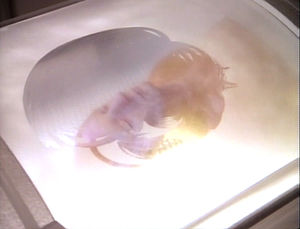Clone
A clone is an identical twin to a living organism artificially grown from sample cells. In reality, a clone has none of the knowledge or experience of the creature that supplied its genetic material, and it grows to maturity at the normal rate for its species. In biological research and engineering, the term 'cloning' may simply mean making copies of a particular gene or genes.
The first cloned mammal was a sheep named Dolly, created in 1997. There is currently some discussion on the matter of Human cloning, including ethical debates.
Clones in Science Fiction
Like many scientific concepts, cloning has been thoroughly misunderstood by people who write science fiction. Shows like Star Trek portray the cloning process as creating a complete mature adult from scratch, as seen in the accompanying picture from the TNG episode "Up The Long Ladder".
Clones also often possess skills at the time of their "birth" that take years for a 'normal' human(oid) to learn, as is the case with the Jem'Hadar, which are grown and combat ready in a matter of days. In the film Multiplicity, the clones even had the complete memories of the original person who donated his genetic material: the clone at first believed himself to be the original person. To say this is not how cloning works is an enormous understatement.
For all their other fanciful or unrealistic aspects, films like Star Wars and Jurassic Park show a far more accurate portrayal of cloning. In Star Wars: Attack of the Clones, we witnessed the clones in various phases of development: embryonic, childhood, and adult. In Jurassic Park, we saw the cloned dinosaurs hatching from eggs.
Clones in Star Trek
- The Dominion use cloning to produce genetically engineered servant races, including the Jem'Hadar and Vorta. They are the only major civilization known to mass-produces clones.
- The Klingon Empire has the technology to create a clone from a DNA sample, grow it at an accelerated rate, and imprint it with fabricated memories.[1]
- Likewise, the Romulan Empire possesses cloning technology; however, the one known clone suffered severe health issues.[2]
- The Mariposa colony was populated entirely by clones.[3]
- Some cloning technology was (illegally) available to Bajoran civilians, as a Bajoran named Ibudan used several clones of himself in an attempt to fake his own murder. These clones could be grown from embryo to adulthood in days.[4]
- Transporters have also created duplicates of people by accident on a couple of occasions.[5]
- Most Federation citizens seem to have a negative attitude toward human cloning, to the point that Dr. Pulaski and Commander Riker destroyed clones that the Mariposa colony had made from their tissues immediately upon finding them. It seems likely that human/sapient cloning is illegal in the Federation.
Clones in Star Wars
- There are at least two methods of producing clones in the Star Wars setting. The people of Kamino produced armies of clones for the Galactic Republic using Jango Fett as a DNA donor. They were able to modify the DNA to some extent, making the clones more obedient and accelerating their growth so they reached maturity in about ten years.[6]
- An alternative (EU) method used "Spaarti cylinders" to rapidly grow clones. Clones created using this technology were usually insane because of a connection through the Force to their DNA donors. The sanity problem could be avoided through either an extended growth period or the use of ysalamiri to block the Force connection.[7]
References
- ↑ TNG "Rightful Heir"
- ↑ Star Trek: Nemesis
- ↑ TNG "Up The Long Ladder"
- ↑ DS9 "A Man Alone"
- ↑ TOS "The Enemy Within", TNG "Second Chances"
- ↑ Star Wars: Attack of the Clones
- ↑ Heir to the Empire series by Timothy Zahn
